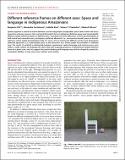Different reference frames on different axes: Space and language in indigenous Amazonians
Author(s)
Pitt, Benjamin; Carstensen, Alexandra; Boni, Isabelle; Piantadosi, Steven T; Gibson, Edward
DownloadPublished version (778.8Kb)
Publisher with Creative Commons License
Publisher with Creative Commons License
Creative Commons Attribution
Terms of use
Metadata
Show full item recordAbstract
<jats:p>Spatial cognition is central to human behavior, but the way people conceptualize space varies within and across groups for unknown reasons. Here, we found that adults from an indigenous Bolivian group used systematically different spatial reference frames on different axes, according to known differences in their discriminability: In both verbal and nonverbal tests, participants preferred allocentric (i.e., environment-based) space on the left-right axis, where spatial discriminations (like “b” versus “d”) are notoriously difficult, but the same participants preferred egocentric (i.e., body-based) space on the front-back axis, where spatial discrimination is relatively easy. The results (i) establish a relationship between spontaneous spatial language and memory across axes within a single culture, (ii) challenge the claim that each language group has a predominant spatial reference frame at a given scale, and (iii) suggest that spatial thinking and language may both be shaped by spatial discrimination abilities, as they vary across cultures and contexts.</jats:p>
Date issued
2022-11-25Department
Massachusetts Institute of Technology. Department of Brain and Cognitive SciencesJournal
Science Advances
Publisher
American Association for the Advancement of Science (AAAS)
Citation
Pitt, Benjamin, Carstensen, Alexandra, Boni, Isabelle, Piantadosi, Steven T and Gibson, Edward. 2022. "Different reference frames on different axes: Space and language in indigenous Amazonians." Science Advances, 8 (47).
Version: Final published version